The Telecom sector ranks eighth out of the ten sectors as detailed in my Sector Rankings for ETFs and Mutual Funds report. It gets my dangerous rating, which is based on aggregation of ratings of four ETFs and twelve mutual funds in the Telecom sector as of January 29, 2013. Prior reports on the best & worst ETFs and mutual funds in every sector are here.
Figure 1 ranks from best to worst the four Telecom Services ETFs and Figure 2 ranks from best to worst the nine Telecom Services mutual funds that meet our liquidity standards. Not all Telecom sector ETFs and mutual funds are created the same. The number of holdings varies widely (from 22 to 52), which creates drastically different investment implications and ratings. The best ETFs and mutual funds allocate more value to Attractive-or-better-rated stocks than the worst ETFs and mutual funds, which allocate too much value to Neutral-or-worse-rated stocks.
To identify the best and avoid the worst ETFs and mutual funds within the Telecom sector, investors need a predictive rating based on (1) stocks ratings of the holdings and (2) the all-in expenses of each ETF and mutual fund. Investors need not rely on backward-looking ratings. My fund rating methodology is detailedhere.
Investors should not buy any Telecom ETFs or mutual funds because none get an Attractive-or-better rating. If you must have exposure to this sector, you should buy a basket of Attractive-or-better rated stocks and avoid paying undeserved fund fees. Active management has a long history of not paying off.
Get my ratings on all ETFs and mutual funds in this sector on my free mutual fund and ETF screener.
Figure 1: ETFs with the Best & Worst Ratings – Top 5
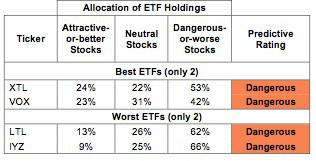 * Best ETFs exclude ETFs with TNAs less than $100 million for inadequate liquidity.
* Best ETFs exclude ETFs with TNAs less than $100 million for inadequate liquidity.
Sources: New Constructs, LLC and company filings
Figure 2: Mutual Funds with the Best & Worst Ratings – Top 5
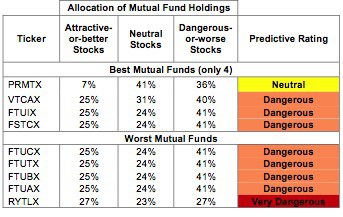 * Best mutual funds exclude funds with TNAs less than $100 million for inadequate liquidity.
* Best mutual funds exclude funds with TNAs less than $100 million for inadequate liquidity.
Sources: New Constructs, LLC and company filings
SPDR S&P Telecom ETF (XTL) is my top-rated Telecom ETF and T Rowe Price Media & Telecommunications Fund, Inc (PRMTX) is my top-rated Telecom mutual fund.
iShares Dow Jones U.S. Telecommunications Index Fund (IYZ) is my worst-rated Telecom ETF and Rydex Series Funds: Telecommunications Fund (RYTLX) is my worst-rated Telecom mutual fund. Both earn my Dangerous rating.
Figure 3 shows that 18 out of the 91 stocks (over 15% of the total net assets) held by Telecom ETFs and mutual funds get an Attractive-or-better rating. However, no Telecom ETFs and no Telecom mutual funds get an Attractive-or-better rating.
The takeaway is: mutual fund managers allocate too much capital to low-quality stocks and Telecom ETFs hold poor quality stocks. Investors deserve better for the fees charged by these ETFs and funds.
Figure 3: Telecom Sector Landscape For ETFs, Mutual Funds & Stocks
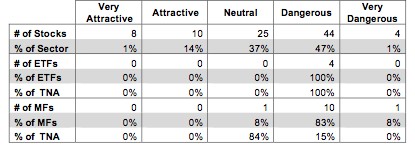 Sources: New Constructs, LLC and company filings
Sources: New Constructs, LLC and company filings
As detailed in “Cheap Funds Dupe Investors”, the fund industry offers many cheap funds but very few funds with high-quality stocks, or with what I call good portfolio management.
Investors need to tread carefully when considering Telecom ETFs and mutual funds, as no ETFs and no Telecom mutual funds in the Telecom sector allocate enough value to Attractive-or-better-rated stocks to earn an Attractive rating. Focus on individual stocks instead.
Harris Corporation (HRS) is one of my favorite stocks held by Telecom ETFs and mutual funds and earns my Very Attractive rating. Harris’ 9% NOPAT CAGR over the past 14 years demonstrates impressive long-term profit growth. Nevertheless, at ~$47/share, the stock’s valuation gives the company no credit for future profit growth. Specifically, the stock trades at a price to economic book value ratio of 0.6, which means the market is predicting a permanent 40% decline in Harris’ NOPAT. That outcome seems unlikely, since the company has won numerous government contracts around the world in the last month.
Leap Wireless International, Inc. (LEAP) is one of my least favorite stocks held by Telecom ETFs and mutual funds and earns my Very Dangerous rating. Its economic earnings per share are -$6.35. LEAP is losing substantial amounts of money for investors. Even with the relatively low share price of ~$5.80, LEAP is too risky an investment. Its current valuation implies a 7% NOPAT CAGR over the next eight years. Even such relatively modest growth expectations are an awful lot to expect from a company without a recent record of consistent economic profitability.
40 stocks of the 3000+ I cover are classified as Telecom stocks, but due to style drift, Telecom ETFs and mutual funds hold 91 stocks.
Figures 4 and 5 show the rating landscape of all Telecom ETFs and mutual funds.
Our Sector Rankings for ETFs and Mutual Funds report ranks all sectors and highlights those that offer the best investments.
Figure 4: Separating the Best ETFs From the Worst ETFs
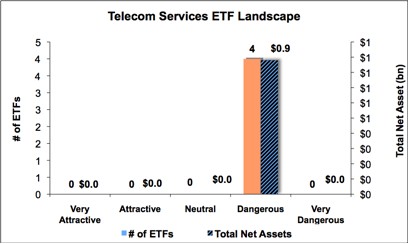 Sources: New Constructs, LLC and company filings
Sources: New Constructs, LLC and company filings
Figure 5: Separating the Best Mutual Funds From the Worst Mutual Funds
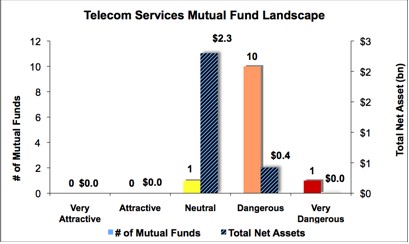 Sources: New Constructs, LLC and company filings
Sources: New Constructs, LLC and company filings
Review my full list of ratings and rankings along with reports on all four ETFs and twelve mutual funds in the Telecom sector.
Sam McBride contributed to this report.
Disclosure: David Trainer and Sam McBride receive no compensation to write about any specific stock, sector or theme.
